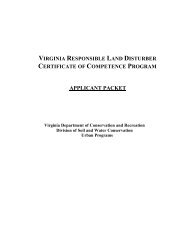Dameron Marsh NAP self-guided field trip guide - Virginia ...
Dameron Marsh NAP self-guided field trip guide - Virginia ...
Dameron Marsh NAP self-guided field trip guide - Virginia ...
You also want an ePaper? Increase the reach of your titles
YUMPU automatically turns print PDFs into web optimized ePapers that Google loves.
Stop 4...<br />
This is a good place to reflect on the history of the area.<br />
• Algonquian Indians and their predecessors lived in this area since at least 6500 BC. Many Prehistoric Native<br />
American village sites are now several hundred yards offshore, due to the rising level of the Bay.<br />
• Captain John Smith’s map of <strong>Virginia</strong> of 1612 suggests that the <strong>Marsh</strong> lay within the chiefdom of Wiccocomico,<br />
known to have had about 130 men in 1600. It was bordered on the south by the chiefdom and possibly<br />
the village of Cuttatawomen.<br />
• The Algonquians lived in villages and dwelt in barrel shaped houses, covered with mats or bark, with a smoke<br />
hole in the top. These were easily disassembled and relocated as weather, farming, and hunting needs dictated.<br />
• They fished and collected oysters and clams from the then crystal blue waters of the Chesapeake Bay We<br />
know they were here because they left behind their trash---a pile of oyster shells, and arrowheads and spear<br />
points that still turn up from time to time in the plowed <strong>field</strong>s. They grew corn, beans, squash, pumpkins,<br />
gourds, sunflowers and tobacco. They also collected a wide variety of plants for both food and medicinal purposes.<br />
Many of which you can see at this stop...<br />
• They ate the fruit from the female Persimmon trees and used Dogbane to make rope and cordage. The berries<br />
were of Winged Sumac were used to make a medicine for stomach pain and the pulp of the stalk was used as a<br />
dye.<br />
• Persimmons (Diospyros virginiana) are the deciduous trees visible all along the trail. They grow to about 50<br />
feet tall and more are found along the old hedgerows in the preserve. In the summer and fall you’ll see the persimmons<br />
hanging on the tree. When ripe they will be an orange fleshy fruit, but remember the old rule, you<br />
must wait until the first frost before trying to eat a persimmon, otherwise they are very astringent and will<br />
pucker your mouth up. There is a nice patch of partridge pea to the left of the sign.<br />
Partidge pea<br />
Cassia facisiculata<br />
(Formerly Chamaecrista)<br />
Persimmon<br />
Diospyrosora virginiana<br />
Barnyard Grass—Enchinochloa spp?
















